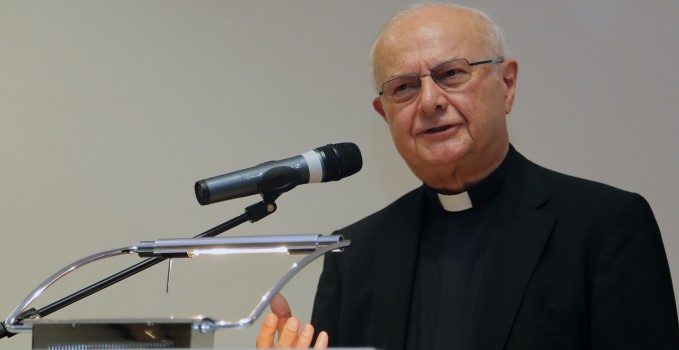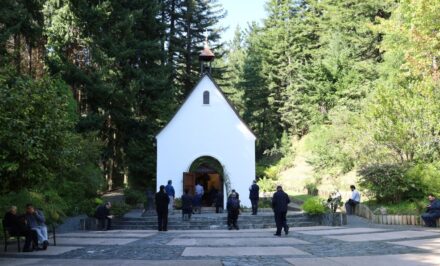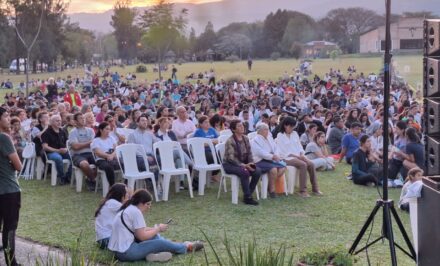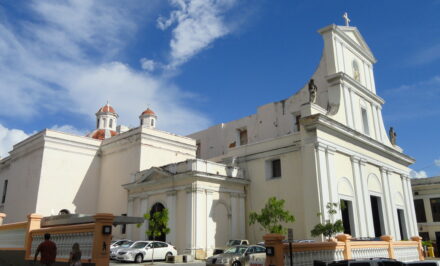org. “Pope Francis looks ahead and calls for a Church that sets out, because “God’s word constantly shows us how God challenges those who believe in him ‘to go forth’” (EG20). Those who only look back and want to preserve it, will lose the future. That is why our Holy Father urges us “to move from a pastoral ministry of mere conservation to a decidedly missionary pastoral ministry”.” Archbishop Emeritus Robert Zollitsch from Freiburg, and Head of the German Bishops’ Conference up until 2013, chose “Evangelii Gaudium” as the theme for the conference he gave in Würzburg, Germany to commemorate Schoenstatt’s hundred years on November 19, 2014 in collaboration with the Wurzburg Cathedral School. In this conference, he spoke about the vision of the church, given and entrusted to Schoenstatt, based on the image of the church developed by Vatican II, and which is becoming clearer in the light of Evangelii Gaudium, Pope Francis’ roadmap for the renewal of the church. Schoenstatt.org gladly presents this conference to the entire Schoenstatt Family. It will be published – chapter by chapter – over the next four weeks.
Vision and Setting Out
The Church on the Way into the Future
Talk given by Emeritus Archbishop Robert Zollitsch DD]
to commemorate Schoenstatt’s hundred years
in co-operation with the Wurzburg Cathedral School
on 19 November 2014, 7 p.m.

With his Apostolic Exhortation “Evangelii Gaudium”, which he published almost exactly a year ago, Pope Francis undertook a great deal and formulated a distinctly ambitious goal. He wanted no less than to “point out new paths for the Church’s journey in the years to come”. For this reason he invited us “to embark upon a new chapter of evangelization” that is marked and borne by the joy of the Gospel.[1] He reacted against the “inner emptiness” (EG1) and pervasive individualistic “desolation and anguish”, and hence a “blunted conscience” (EG2) that only looks back and wants to hold onto the old.
He looked forward and called for a Church that sets out, because “God’s word constantly shows us how God challenges those who believe in him ‘to go forth’” (EG20). Whoever only looks back and wants to preserve, will lose the future. That is why our Holy Father requires us “to move from a pastoral ministry of mere conservation to a decidedly missionary pastoral ministry”.[2]
I don’t know, dear confreres, reverend Sisters and Brothers, when I have last read a papal document with such inner joy and such great profit as I experienced when I read Evangelii Gaudium. I studied theology during the Second Vatican Council, and was ordained a priest in 1965, the year it closed. You can hardly imagine how we literally soaked up everything that was reported from the Council, or how much the perspectives it opened up fascinated us. Fifty years later Pope Francis takes the initiative and challenges us to continue along the path of the Second Vatican Council today.
Two weeks ago today I took part in the opening ceremony in Constance of the six hundredth anniversary of the Council of Constance. This Council solved the “causa unionis” and restored the unity of the Church that had been broken by three competing Popes. However, in the “causa reformationis”, the question of the reform of the Church, although it formulated a few hesitant decrees, in practice it achieved nothing. Six hundred years after the Council of Constance, and fifty years after the Second Vatican Council, the question of the renewal of our Church, the ecclesia semper reformanda, again arises for our times. That is why Pope Frances wanted “to present some guidelines which can encourage and guide the whole Church in a new pahse of evangelization, one marked by enthusiasm and vitality” (EG 17). It is a matter of no less than a “pastoral and missionary conversion” of the Church (EG 25). Our Holy Father speaks about an “heroic and impatient struggle for renewal” (EG 26).
You invited me to talk to you this evening because the Schoenstatt Movement celebrated its hundredth anniversary a month ago. It is the only large, worldwide spiritual movement of the twentieth century that started in Germany. Schoenstatt appeared as a movement of renewal, that aimed at forming the new person in the new community and renewing the community of the Church in the strength of the Gospel at the hand of Mary. In the process the Schoenstatt Family has allowed God to reveal step by step a God-given vision of the Church that we will be dealing with this evening. I will attempt to light up this vision of the Church based on the Second Vatican Council image of the Church, and against the background of the Apostolic Exhortation “Evangelii Gaudium”. Their inner harmony is, in my opinion, such that I usually won’t have to distinguish between the individual currents. I will do this in four steps:
- The Church on pilgrimage that is at home in a foreign world;
- The Church that allows herself to be guided by God’s Spirit;
- The Church appointed to serve, and
- The Church, Communio, that lives from the covenant.
All this against the background of the question as to what all this means for a Church that honours Mary as her mother.
The Church at home in a foreign world[3]
We human beings are always tempted, like Peter on the Mount of the Transfiguration, to build our huts in this world and to settle down here. Pope Francis contrasts this with the “Church setting out”, and takes up what the Second Vatican Council Constitution on the Church, Lumen Gentium, expressly highlights as an essential characteristic of the Church.
As a community of believers we are God’s chosen people in this world. Baptised in Jesus Christ, we are Christ’s Body and thus united with one another, directed to one another, and dependent on one another like the members of the body. We are God’s new creation in this world, called to imitate Christ, called to holiness, on the way with a promise.
In and through us God’s Kingdom is present in this world. Yet we are not the Kingdom of God, nor is the Church. However, she is the sign and instrument shining out ahead of the Kingdom of God. We live in this world. Yet we are “at home in a foreign world”. We have no home here, because our home is in heaven (Phil 3,20). We are pilgrims, a pilgrim Church, on the way to God’s kingdom, on the way to that goal God has promised us, and that is outside this world. So we look towards the new heaven and the new earth (Rev 21), on pilgrimage “far from the Lord” (cf. 2 Cor 5,8), looking for the coming and permanent city (cf. Heb 13,14)”.[4]
I know that this doesn’t easily go under our skin, because we have settled down comfortably in this world, and because we are part of this world. Accordingly we have internalised the visible part of the Church, its clear hierarchical structure and mighty fortress founded on the unshakeable rock of Peter. We identify with it and have anchored ourselves to it. Yet now the Council points out that we are by no means the kingdom of God, nor are we an immovable fortress; we are pilgrims on the way to this one goal that is ahead of us. In the process, we have to allow ourselves to be constantly shown the way to this goal through listening to one another and through, together, listening to God.
Fr Joseph Kentenich, who firmly believed in God’s Providence, and who trusted that he was at work in history and in his guidance, allowing himself to be shown the way bit by bit in his life, understood clearly what this statement meant for the Church. He made use of an image that contained powerful tensions. He spoke about the Church, the rock of Peter, an erratic block in the breaking waves, starting to move and setting off again on pilgrimage towards the God-given promise.
The image of a rock, of a rock that begins to move and roam, tells us a great deal. It makes tangible the tension alive in the Church, and to which the Second Vatican Council consciously took a stand. The Church is a pilgrim community on the way. While in this world she has not reached her goal, she is not complete. That is why she may not stand still. She needs to be constantly setting out and constantly renewing herself. For us, as the Church and as individual Christians, this means taking it seriously that we are strangers in this world, pilgrims in and with the Church.
The Church that waits too often and too long for people to come to her, sets out, as Pope Francis formulated it, and again goes out to the people, even to the outskirts of society. She is not afraid of being dented, wounded and dirtied “because it has been out on the streets” (EG 49). It isn’t important to her to be the centre of attention (EG 49). She knows that she is on the way with the people to Jesus Christ, and with him. Just as Jesus did not wait for the people to come to him, but went out to meet them, addressed them and asked, “What do you want me to do for you?” (cf. Mk 10,51), so we, as the Church, want to visit people were they are living, in the most disparate circumstances, and bring home to them the message of the Easter victory of Jesus Christ through our lives and our words. The vision of the Second Vatican Council, of our Holy Father, Pope Francis, and Schoenstatt, is of a Church that sets out on pilgrimage with dynamic life; it is the vision of a vital community of faith, gripped by God and equally sensitive to the questions and search of people. It is a Church that doesn’t impose herself, but humbly bears witness, and at the same time has the courage to invite herself, as Jesus did with Zacchaeus (Lk 19,5), in order to bring the Gospel.
This path is more difficult than organising communities and creating structures. That is because the faith, and a life of witness by faith, is always connected with daring. Faith becomes strong through the hope from which we live, and upholds us. It has a goal, and is a pilgrim path to a goal that is not in this world. Such a pilgrim path needs, as with Abraham, the readiness to take leave; the readiness to break open rigid forms, hardened fronts and rooted disappointments towards Jesus Christ and his Gospel. A pilgrim Church, a “go into Church”, is a Church on the way, a Church at the roadside and on the roads of life of the people around us.
A Church on the paths of people through their lives looks at them with the eyes and heart of Jesus. Each person counts. Each one is unique and called by Christ. In this Church it comes alive. She discovers their richness and hence the variety given to them. She see the rich gifts and the charism of the people of God. She intuits the longing of people, and knows about their limitations and need for help. This Church “feels”, as Pope Francis writes, “an endless desire to show mercy” (EG 24). “She is familiar with patient expectation and apostolic endurance.” She has much patience. (EG 24). “She cares for the grain and does not grow impatient with the weeds” (EG 24).
This Communio of the Church, as long as she is on pilgrimage on earth in a foreign country, is always a community of saints and sinners at the same time. It requires repeated reassurance about the goal; but always also mercy and a lot of staying power while trusting in God’s Holy Spirit. At the same time it requires constant setting off from our comfort zone in this world towards God and people, in order to bring them the Gospel.
The Second Vatican Council’s Constitution on the Church sees Mary as the archetype of the eschatological Church on pilgrimage in this world, “In the meantime the Mother of Jesus in the glory which she possesses in body and soul in heaven is the image and beginning of the Church as it is to be perfected in the world to come. Likewise she shines forth on earth, until the day of the Lord shall come (cf. 2 Pet 3,10), a sign of certain hope and comfort to the pilgrim People of God” (LG 68). The Church is not only aware that she is most closely united with Mary, and looks not only at “her apostolic mission” (LG 65), but also trusts gratefully that “in her maternal charity … (Mary) cares for the brethren of her Son, who still journey on earth” (LG 62), she accompanies them and goes before them on their way. For, as Pope Francis puts it, “with the Holy Sprit, Mary is always present in the midst of the people” (EG 284). Since Jesus “did not want us to journey without a mother” (EG 285), he gave her to us to accompany us through life (EG 286). “Her exceptional pilgrimage of faith represents a constant point of reference for the Church” (EG 287).[5] She is the woman setting out. When she experienced through the message of the angel that she was to become the mother of the Son of God, the first thing she did was to set off hurriedly from Nazareth (LK 1,39); cf. EG 288) to go to her cousin, Elizabeth, in order to bring her Son to the people even before he was born.
This characterises and sets its stamp on the life and work of Schoenstatt as an apostolic movement. From the first Fr Kentenich, and hence Schoenstatt, took his bearings from Mary, the Mother of the Church and the woman who sets out, and he experienced that she actively guided and accompanied him. Mary stands for dynamism and the way to people. She stands at the same time for a Church, which like her is borne by the Holy Spirit and led by the Spirit, so that from day to day she may walk her pilgrim path in faith in God’s – sometimes also surprising – guidance in everyday life. Mary, who is filled and imbued with the God’s Holy Spirit (cf. Lk 1,35); who not only heard God’s word, but also preserved it in her heart and reflected on it (cf. Lk 2,19.51). opens our eyes, hearts and ears to recognise the signs of the times, and to interpret them in the light of the Gospel (cf. Mt 16,4; GS 4).
Just as Mary sets off also today to the people, and addresses them, so in our present times we experience a fascinating phenomenon in the “Pilgrim Mother”. In the last century the Deacon João Luiz Pozzobon in Brazil took the picture of the Mother Thrice Admirable thousands of kilometres on pilgrimage on foot to the people for fifty-five years, and in the process experienced an unexpected chain reaction. Today 200,000 pictures of the Pilgrim Mother are on the way to the people in almost a hundred countries.
[1] Pope Francis, Apostolic Exhortation “Evangelii Gaudium”, of 24 November 2013. Quotes taken from §1.
[2] EG 15, with reference to the Aparecida Document §548.
[3] Cf. Manfred Entrich, Joachim Wanke (ed), In fremder Welt zu Hause. Anstöße für eine neue Pastoral, Stuttgart 2001 (At home in a foreign world – Impulses for a new pastoral practice).
[4] Cf. Second Vatican Council, Lumen Gentium, 9.
[5] Here Pope Francis is quoting from Pope John Paul II’s encyclical “Redemptoris Mater”, Nr 6.
Part II: The Church who allows herself to be led by God’s Spirit. To be published next Saturday














